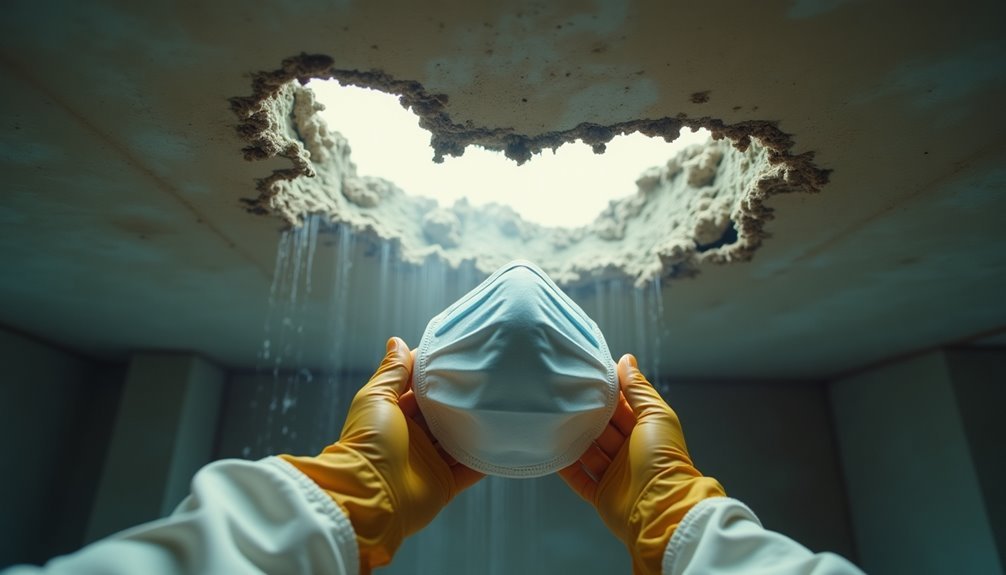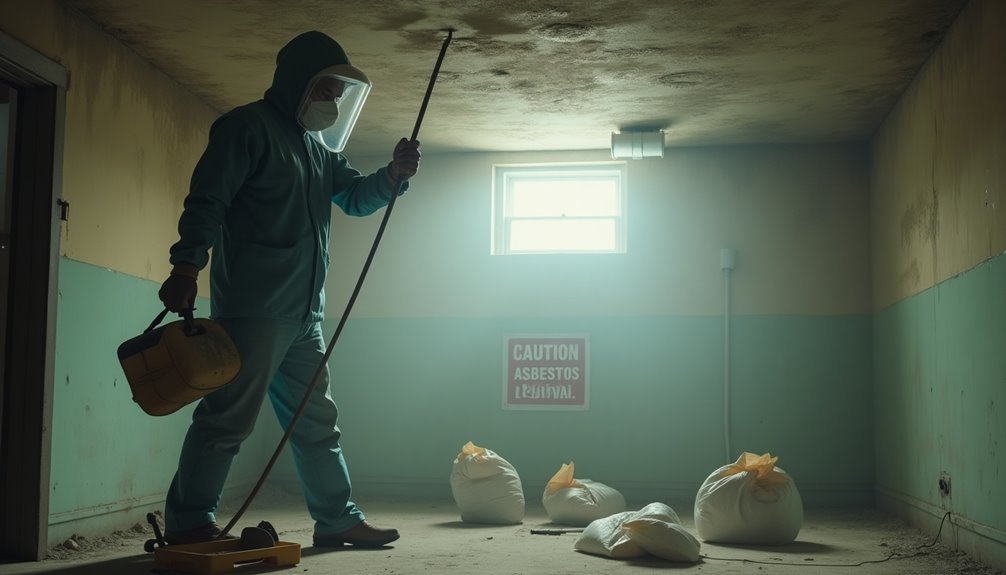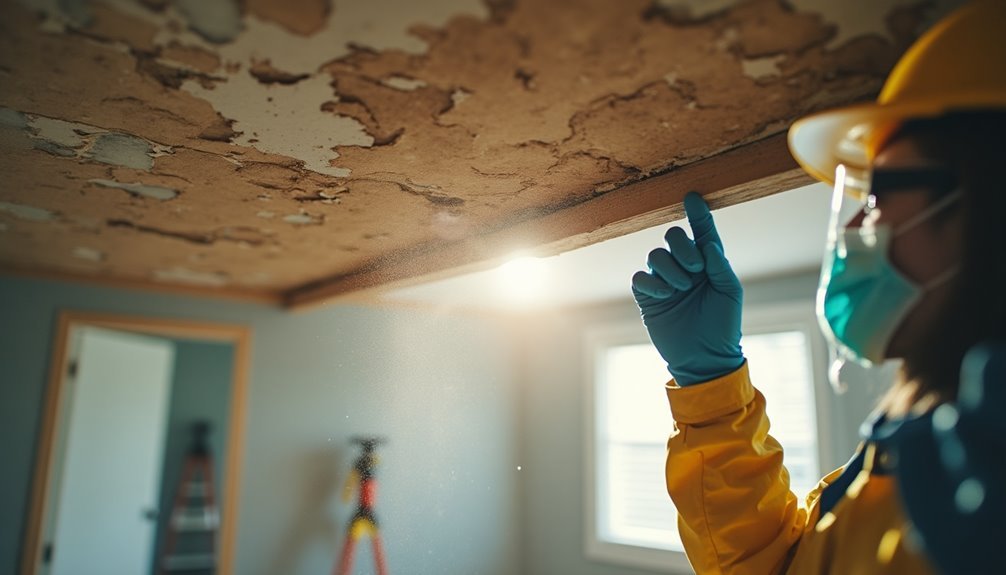Asbestos abatement should be a priority for your home or business due to the significant health risks associated with asbestos fibers, which can lead to long-term respiratory diseases and increased lung cancer risk. Ignoring this issue can result in financial burdens, as removal costs and legal liabilities can climb steeply. Additionally, proper abatement helps protect the environment by preventing contamination. Engaging certified professionals ensures compliance with safety regulations, minimizing risks during the process. By prioritizing asbestos abatement, you safeguard both occupants and your investment, revealing more about the complexities and solutions available in managing this hazardous material.
Health Risks of Asbestos

As you navigate environments that may contain asbestos, it's crucial to understand the significant health risks associated with exposure. Asbestos fibers can linger in the air for days, and inhaling them can lead to serious diseases. Once inhaled, these fibers can become lodged in your lung tissue, resulting in inflammation and scarring that may develop into conditions like asbestosis, a chronic disease characterized by lung damage. Notably, all asbestos fibers are harmful if breathed, making it imperative to treat potential asbestos exposure with utmost seriousness.
The risks escalate with time, as symptoms may take 20 to 50 years to manifest. You might initially dismiss vague symptoms such as coughing or shortness of breath, but persistent signs, including wheezing and chest pain, warrant immediate attention. Notably, exposure to asbestos dramatically increases your risk of lung cancer, especially if you smoke.
To protect your health, regular health monitoring is essential. Inform your healthcare provider about any potential asbestos exposure and undergo routine screenings for early detection of related diseases. This proactive approach can empower you to take control of your health and mitigate the risks associated with asbestos exposure. Remember, awareness and vigilance are key to safeguarding your well-being.
Financial Implications of Asbestos
Understanding the health risks associated with asbestos exposure is only part of the equation; the financial implications can be equally significant. You need to grasp the financial risks involved in asbestos management and removal. Here's a concise cost analysis to consider:
| Cost Category | Average Cost | Notes |
|---|---|---|
| Asbestos Removal | $2,215 | Ranges from $1,192 to $3,255 |
| Interior Removal | $5 – $20 per square foot | Depends on complexity |
| Exterior Removal | $50 – $150 per square foot | Typically more expensive |
| Professional Surveys | £200 – £1,000 | Essential for safety compliance |
| Disposal Fees | $10 – $50 per cubic yard | Varies based on project type |
Businesses spend over £1.5 billion annually on asbestos management, with significant productivity losses due to asbestos-related illnesses. Additionally, legal and insurance implications can lead to millions in settlements and increased premiums. Properties with asbestos can lose market value, but investing in professional abatement can enhance it. By addressing these financial implications, you're not just protecting health; you're also safeguarding your financial future. Moreover, the economic costs associated with asbestos exposure extend beyond immediate removal expenses, impacting workforce productivity and healthcare systems.
Environmental Considerations

When addressing asbestos abatement, it's crucial to prioritize safe disposal practices to prevent environmental contamination. By ensuring that asbestos-containing materials are properly managed, you not only protect local ecosystems but also promote overall public health. Implementing these measures effectively preserves the integrity of air, water, and soil in your community.
Safe Disposal Practices
Effective disposal practices for asbestos are crucial in preventing environmental contamination and protecting public health. When you handle asbestos, you must recognize that improper disposal can lead to hazardous waste issues, impacting both land and air quality. Here's how to ensure safe disposal:
- Wetting Materials: Always wet asbestos materials before removal to minimize fiber release.
- Use Proper Containers: Seal asbestos waste in leak-proof, non-returnable containers, like heavy-duty plastic bags or drums.
- Label Carefully: Clearly label all containers with warning signs indicating the presence of asbestos to ensure proper handling.
- Licensed Facilities: Dispose of asbestos only at licensed disposal sites to avoid illegal dumping, which can lead to severe penalties.
Ecosystem Health Preservation
Proper asbestos disposal practices not only protect human health but also play a vital role in preserving ecosystem health. When asbestos is improperly handled, it can contaminate soil, water, and air, posing risks to local wildlife and disrupting natural ecosystems. By implementing effective asbestos abatement, you contribute to ecosystem restoration and wildlife protection.
| Benefit of Asbestos Abatement | Impact on Ecosystem Health | Long-term Sustainability |
|---|---|---|
| Prevents environmental contamination | Protects biodiversity | Ensures safe habitats |
| Maintains water quality | Safeguards aquatic life | Promotes healthy soil |
| Preserves natural habitats | Supports plant life | Contributes to conservation efforts |
| Compliance with regulations | Minimizes ecological damage | Sustains ecosystem integrity |
The Need for Professional Help
When dealing with asbestos, you'll quickly realize that specialized expertise is essential for safe abatement. Professionals not only ensure compliance with safety regulations but also utilize advanced equipment to manage risks effectively. Relying on their knowledge and tools minimizes the potential health hazards associated with asbestos exposure.
Specialized Expertise Required
Navigating the complexities of asbestos abatement requires specialized expertise that most individuals simply don't possess. Without professional guidance, you're risking non-compliance with stringent asbestos regulations, which can lead to significant legal and financial repercussions. Here's why enlisting certified professionals is essential:
- Training and Certification: Professionals undergo mandatory training courses approved by the EPA or state authorities, ensuring they meet certification requirements. Many disciplines exist, each with its own training and testing standards.
- Unique Qualifications: Inspectors and management planners often hold degrees and have specific experience requirements, making their expertise invaluable for effective abatement planning.
- State Licensing: Almost every state mandates that asbestos abatement professionals obtain licenses. Certified supervisors oversee all abatement activities, ensuring compliance with local laws.
- Thorough Assessments: Certified inspectors conduct comprehensive inspections, including visual examinations and laboratory analyses. Their expertise allows for accurate assessments and effective abatement strategies.
Safety Compliance Assurance
Asbestos abatement frequently involves complex procedures that demand strict adherence to safety compliance standards, underscoring the necessity of professional assistance. Without certified experts, you risk not only health hazards but also legal repercussions. Professionals implement safety protocols that significantly reduce exposure to airborne asbestos fibers, which can lead to severe illnesses like lung cancer and mesothelioma.
Moreover, compliance audits are critical to ensure that all regulations set by OSHA and the EPA are met. Here's a concise breakdown of the key advantages of hiring professionals for asbestos abatement:
| Benefits | Importance |
|---|---|
| Trained personnel | Reduces risk of exposure |
| Legal adherence | Avoids fines and project shutdowns |
| Thorough cleanup | Prevents contamination and health risks |
| Comprehensive abatement plans | Ensures safety protocols are rigorously followed |
Advanced Equipment Utilization
Effective asbestos abatement relies heavily on advanced equipment utilization, making professional help essential. When tackling this hazardous material, you need to leverage technology and expertise that most homeowners or business owners simply don't possess. Here's why relying on professionals is crucial:
- Robotic Systems: These enhance safety by minimizing human exposure. Equipped with high-precision tools, they identify and remove asbestos efficiently.
- Chemical Treatments: Professionals use eco-friendly solvents that alter asbestos fibers' molecular structure, making them less harmful. This method is safer for both workers and the environment.
- Specialized Vacuums: HEPA-filtered vacuums and air scrubbers are critical for capturing particles and maintaining clean air throughout the abatement process.
- Remote Monitoring: Advanced technologies allow real-time oversight of air quality and worker safety, ensuring compliance and reducing risk.
Understanding the Abatement Process

When it comes to understanding the abatement process, you'll find that it involves a series of carefully controlled steps designed to safely remove asbestos while minimizing exposure risks. The first step employs effective containment strategies, isolating the work area with impermeable barriers. This prevents asbestos fibers from escaping and protects surrounding environments.
Next, air filtration systems equipped with HEPA filters are installed to maintain negative pressure, ensuring that any contaminated air is contained and filtered before being released outside. Continuous monitoring of air quality during this phase is crucial to ensure safety.
Once containment is established, the actual removal of asbestos begins. Abatement techniques like wetting materials reduce airborne fibers, while specialized tools ensure minimal dust creation. After removal, thorough decontamination of the work area follows, utilizing HEPA vacuums to capture residual particles.
Finally, asbestos waste is double-bagged and disposed of in licensed landfills, adhering to strict regulations. If complete removal isn't feasible, encapsulation techniques are applied to seal off any remaining fibers. Understanding this intricate process empowers you to prioritize safety and compliance in asbestos abatement.
Importance of Compliance
Compliance with asbestos regulations is crucial for ensuring safety and mitigating health risks associated with exposure. By adhering to these regulatory obligations, you not only protect yourself but also those who work or live in your environment. The benefits of compliance are significant:
- Avoid Legal Consequences: Non-compliance can lead to hefty fines and legal liabilities, jeopardizing your financial stability.
- Enhance Property Value: Properties that meet safety regulations are more marketable and valued higher due to reduced risks.
- Protect Health and Safety: Following regulations helps control asbestos fiber release, safeguarding occupants from serious health issues.
- Meet Stringent Standards: Many state and local regulations exceed federal requirements, ensuring even higher safety and compliance standards.
Long-Term Monitoring Strategies

Long-term monitoring strategies are essential for managing asbestos risks effectively over time. By implementing routine asbestos surveys, you can periodically assess the condition of known asbestos-containing materials (ACMs) in your building. This proactive approach not only helps ensure compliance with safety regulations but also mitigates the ongoing threat of asbestos exposure. Combining visual inspections with minor intrusive work, these surveys maintain up-to-date records of ACM conditions.
Air monitoring techniques play a crucial role, as they involve taking samples within the breathing zone to determine airborne asbestos fiber levels. Clearance monitoring, conducted post-removal, ensures the area is safe for reoccupation, adhering to strict safety criteria.
Additionally, regular medical monitoring for workers exposed to asbestos is vital. This includes health checks, lung function tests, and maintaining personal exposure records, which aid in early detection of asbestos-related health issues.
Preventive maintenance and regular inspections are also key components of long-term strategies. By detecting signs of wear and planning renovations carefully, you can avoid disturbing asbestos materials, ensuring a safer environment. Ultimately, these comprehensive monitoring techniques empower you to take control of asbestos risks effectively.
Educating Occupants and Workers
Effective asbestos management doesn't just rely on monitoring and maintenance; it also heavily depends on the education of all occupants and workers in the environment. Understanding the risks of asbestos exposure is essential to ensure a safe space for everyone, especially given that children are more vulnerable than adults. Here are four key components of educating occupants and workers:
- Worker Training: Employers must provide thorough training on asbestos handling, including the health risks and proper use of safety gear. OSHA mandates this training upon job initiation and annually thereafter.
- Occupant Awareness: Inform all occupants about the presence of asbestos, focusing on the differences between intact and damaged materials. Knowledge is power in preventing accidental exposure.
- Communication: Keep everyone updated on asbestos management plans and inspection results. Transparency fosters trust and awareness.
- Regular Updates: Reinforce the importance of ongoing education through regular informational sessions to keep everyone informed about safe practices and any changes in asbestos conditions.
Planning for Renovations

When planning renovations in an environment that may contain asbestos, it's crucial to approach the process systematically. Start with asbestos testing to identify and assess any asbestos-containing materials (ACMs) present. Engage certified inspectors to conduct thorough evaluations and gather samples for lab analysis.
Here's a simple table to guide you through the planning process:
| Step | Action |
|---|---|
| Inspection | Conduct a thorough inspection and collect samples. |
| Abatement Plan | Create a detailed plan that complies with regulations. |
| Notification | Notify regulatory agencies and obtain necessary permits. |
| Execution | Seal off areas and use specialized equipment. |
| Safety Measures | Ensure protective gear and proper waste disposal. |
Once you've established a solid foundation through these steps, you can confidently move forward with your home renovation. Remember, planning is key to ensuring safety and compliance throughout the process. By prioritizing asbestos abatement, you liberate your space from potential hazards, paving the way for a safe and successful renovation.
Conclusion
In conclusion, prioritizing asbestos abatement in your home or business is crucial for safeguarding health and financial stability. Did you know that the U.S. Environmental Protection Agency estimates that over 1.3 million workers are exposed to asbestos on the job each year? By addressing asbestos risks proactively, you not only protect occupants but also enhance property value and compliance with regulations. Investing in professional abatement services ensures a safer, healthier environment for everyone involved.
